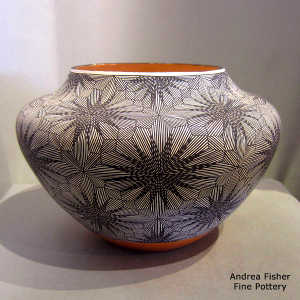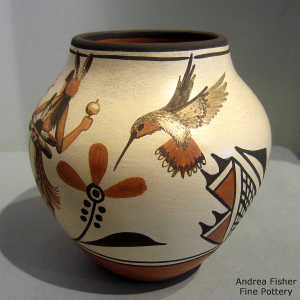Design Elements: Paint

Marbleized clay jar decorated with a 4-panel black geometric design
by Calvin Analla Jr, Laguna
5 in H by 5.75 in Dia

Polychrome jar decorated with a black-on-white fine line and geometric design
by Franklin Peters, Acoma
6.75 in H by 9.75 in Dia

Black-on-black plate with a ring of feathers design by Maria Martinez, San Ildefonso
1 in H by 11 in Dia
1943-1956
Signed: Marie + Santana
More than 1,000 years ago, Native American potters were painting images, symbols and designs on their pots with "brushes" made from chewed yucca leaves, chewed at the tip to create small soft bristles. The "paint"* they used was of two types:
a) Carbon: Carbon "paint"* is made from plant material, boiled and reduced to a sticky mass. When fired, the organic paint is charred in the heat, giving it permanence and a black color.
b) Mineral: Mineral stains are made from iron, manganese, or copper rocks, alone or in combination. These pigments are finely ground and mixed in a solution of water or water with added clay to form a color-saturated slip.
Red and Red-Brown "paint"* is made from a thin, iron-rich slip that is applied to the surface of a pot either through slipping or brushing. White "paint"* is obtained from very pure clay, like kaolin, that is free from any traces of iron. Black "paint"* applied to polychrome has the most variation in its materials, and the technology involved in its application and firing is the most complex. Black paint is made from carbon, minerals or a combination of the two. Organic black paint, or carbon paint, can also be obtained from a variety of plant sources. Inorganic paint, or mineral paint, is mostly obtained from grinding iron or manganese ores.
Carbon/mineral: Some "paints"* were made from a combination of minerals and organic materials. The organic material acted as a binder to boost adherence of the mineral "paint"* to the clay surface.
*"Paint" is used loosely to refer to the mineral and/or organic pigments that were applied to the surface(s) a pot with a brush in a manner similar to how we generally paint today.

Polychrome thin-neck jar with a sgraffito and geometric design
by Diego Valles, Mata Ortiz
8 in H by 6.25 in Dia

Black-on-red jar decorated with a deer, heart line and geometric design by Anderson Peynetsa, Zuni 6.5 in H by 6 in Dia

Polychrome jar decorated with a dancer, flowers, hummingbird, butterfly and geometric design
by Elizabeth and Marcellus Medina, Zia 6 in H by 6 in Dia
Traditional potters don't usually travel more than a few miles to find the materials they need to make and decorate their pots. Because of the different geologies in the different areas, the clay used by the potters will be very different. Acoma potters generally use a boiled-down beeweed to get their black and ground mineral to get their red and orange. Other colors come from smaller deposits of clay scattered around the pueblo area. Santa Clara potters tend to carve or etch (sgraffito) their pots. Those who paint use slips made of beeweed and local clays. San Ildefonso potters make their black-on-black using a boiled-down beeweed mix to produce the matte against the highly polished backgrounds. Jemez clay is grainy and comes in several different colors. For painting purposes they have to grind it very, very fine as the Jemez live in a predominantly volcanic area. Hopi clay is fine and relatively easy to polish. Most of their colors are derived from finely ground minerals. Taos clay tends to be micaceous right out of the ground. Most Diné pottery fires to varying shades of brown, most likely because they dig most of their clay in the Black Mesa area of northeastern Arizona. Most Diné Folk Art pottery is made of that brown clay, then painted with acrylic colors after firing. Mata Ortiz has about 10 different clay and mineral colors available in the area, although some Mata Ortiz potters have told me they travel 100 miles and more to find some colors.

